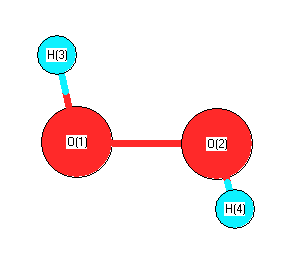Jump to
S1C2
Energy calculated at QCISD(T)/aug-cc-pVDZ
| | hartrees |
|---|
| Energy at 0K | -151.243767 |
| Energy at 298.15K | -151.246043 |
| HF Energy | -150.798526 |
| Nuclear repulsion energy | 36.268885 |
The energy at 298.15K was derived from the energy at 0K
and an integrated heat capacity that used the calculated vibrational frequencies.
Vibrational Frequencies calculated at QCISD(T)/aug-cc-pVDZ
| Mode Number |
Symmetry |
Frequency
(cm-1) |
Scaled Frequency
(cm-1) |
IR Intensities
(km mol-1) |
Raman Act
(Å4/u) |
Dep P |
Dep U |
|---|
| 1 |
A |
3750 |
3666 |
|
|
|
|
| 2 |
A |
1408 |
1376 |
|
|
|
|
| 3 |
A |
841 |
823 |
|
|
|
|
| 4 |
A |
385 |
377 |
|
|
|
|
| 5 |
B |
3750 |
3667 |
|
|
|
|
| 6 |
B |
1300 |
1271 |
|
|
|
|
Unscaled Zero Point Vibrational Energy (zpe) 5716.8 cm
-1
Scaled (by 0.9778) Zero Point Vibrational Energy (zpe) 5589.9 cm
-1
See section
III.C.1 List or set vibrational scaling factors
to change the scale factors used here.
See section
III.C.2
Calculate a vibrational scaling factor for a given set of molecules
to determine the least squares best scaling factor.
Geometric Data calculated at QCISD(T)/aug-cc-pVDZ
Point Group is C2
Cartesians (Å)
| Atom |
x (Å) |
y (Å) |
z (Å) |
|---|
| O1 |
0.000 |
0.740 |
-0.059 |
| O2 |
0.000 |
-0.740 |
-0.059 |
| H3 |
0.798 |
0.898 |
0.473 |
| H4 |
-0.798 |
-0.898 |
0.473 |
Atom - Atom Distances (Å)
| |
O1 |
O2 |
H3 |
H4 |
| O1 | | 1.4805 | 0.9719 | 1.8980 |
O2 | 1.4805 | | 1.8980 | 0.9719 | H3 | 0.9719 | 1.8980 | | 2.4016 | H4 | 1.8980 | 0.9719 | 2.4016 | |
 More geometry information
More geometry information
Calculated Bond Angles
| atom1 |
atom2 |
atom3 |
angle |
|
atom1 |
atom2 |
atom3 |
angle |
| O1 |
O2 |
H4 |
99.320 |
|
O2 |
O1 |
H3 |
99.320 |
Electronic energy levels
Charges, Dipole, Quadrupole and Polarizability
Jump to
S1C1
Energy calculated at QCISD(T)/aug-cc-pVDZ
| | hartrees |
|---|
| Energy at 0K | -151.241910 |
| Energy at 298.15K | |
| HF Energy | -150.796410 |
| Nuclear repulsion energy | 36.114060 |
The energy at 298.15K was derived from the energy at 0K
and an integrated heat capacity that used the calculated vibrational frequencies.
Vibrational Frequencies calculated at QCISD(T)/aug-cc-pVDZ
| Mode Number |
Symmetry |
Frequency
(cm-1) |
Scaled Frequency
(cm-1) |
IR Intensities
(km mol-1) |
Raman Act
(Å4/u) |
Dep P |
Dep U |
|---|
| 1 |
Ag |
3774 |
3690 |
|
|
|
|
| 2 |
Ag |
1512 |
1478 |
|
|
|
|
| 3 |
Ag |
837 |
818 |
|
|
|
|
| 4 |
Au |
308i |
301i |
|
|
|
|
| 5 |
Bu |
3783 |
3699 |
|
|
|
|
| 6 |
Bu |
1222 |
1195 |
|
|
|
|
Unscaled Zero Point Vibrational Energy (zpe) 5409.7 cm
-1
Scaled (by 0.9778) Zero Point Vibrational Energy (zpe) 5289.6 cm
-1
See section
III.C.1 List or set vibrational scaling factors
to change the scale factors used here.
See section
III.C.2
Calculate a vibrational scaling factor for a given set of molecules
to determine the least squares best scaling factor.
Geometric Data calculated at QCISD(T)/aug-cc-pVDZ
Point Group is C2h
Electronic energy levels
Charges, Dipole, Quadrupole and Polarizability
